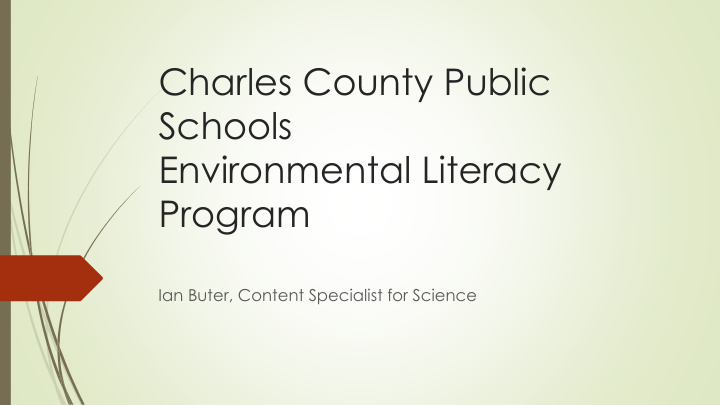



Charles County Public Schools Environmental Literacy Program Ian Buter, Content Specialist for Science
About Charles County Public Schools Charles County Public Schools is one of the fastest growing school systems in Maryland. Located south of Washington, D.C., Charles County is considered part of the Washington, D.C. metropolitan area. Charles County has a population of 154,747 and is located in Southern Maryland. The mission of Charles County Public Schools is to provide an opportunity for all school-aged children to receive an academically challenging, quality education that builds character, equips for leadership and prepares for life, in an environment that is safe and conducive to learning.
Our schools in Charles County, Maryland Our elementary schools are composed of students from prekindergarten to grade five; there are 21 elementary schools and one under construction. Our middle schools have students from sixth to eighth grade; there are eight middle schools. Our high schools serve students in grades nine through 12; there are seven high schools. We also have four centers for education. Enrollment for our school system is approximately 27,000 students.
The Importance of Environmental Literacy It is essential that our students be exposed to and learn about environmental issues within our local and global ecosystems. Through our science curricula (grades K-12), students investigate a variety of local environmental challenges within our local and global watershed. In addition to learning about these challenges, it is imperative that we work with our students to develop the skills necessary to address these challenges as both students and future 21 st century citizens.
Our Program Through our partnership with the Alice Ferguson Foundation, we aim to design and implement a systematic, integrated Meaningful Watershed Educational Experience (MWEE) that empowers middle and high school students in terms of stewardship and greater scientific understanding. The overall structure for the MWEE is an integrated science unit that will take place at the 7 th -grade (Life Science) level, and at the high school level in the content areas of Biology and Earth Systems.
Goals of the Program To promote stewardship and a science-informed society, students are exposed to concepts and methods included in the learning standards for STEM, Science, and Environmental Literacy, as well as, parameters set for Student Service Learning and MWEE’s through classroom activities and field studies in local contexts Students are engaged in science leading to improved behavior and academic achievement. The MWEE provides context for student learning making classroom lessons more relevant to students’ lives and the local environment.
Partnership for our Program We have partnered with the Alice Ferguson Foundation (AFF) for this initiative. The mission of AFF is to connect people to the natural world, sustainable agricultural practices and the cultural heritage of their local watershed through education, stewardship and advocacy. Partnership with AFF has allowed us to use Bridging the Watershed (BTW) modules as a our model for MWEE’s . Module examples include Exotic Invaders, Talkin’Trash, Water Canaries, Watershed Watchdogs, and Don’t Get Sedimental.
Approaches to our Program Targeted Professional Development-we have facilitated summer institutes, training during county-wide in-services, and paid evening professional development trainings for all MS and HS science teachers. Integrated Curriculum-science curriculum has been written and revised as a means to better integrate our Bridging the Watershed (BTW) modules into our science curriculum. Field Study Outreach Coordinator-a portion of our NOAA BWET funds pays a salary for a MWEE outreach coordinator (Jen Young). She schedules and facilitates PD and field studies onsite at our schools. Alice Ferguson Foundation personnel coordinates/facilitates our field studies at state and national parks.
Successes of our Program 17-18 (Year 1) Total students participating in Meaningful Watershed Educational Experiences (MWEE’s) 3,610 students Middle School-2,488 High School-1,122 Total Field Studies-127 Total Teachers Trained-45 MS/HS teachers PD consisted of Summer Institutes Curriculum Development Units written to align BTW modules with Grade 7 science, Earth Systems, and Biology
Successes of our Program 18-19 (Year 2) Total students participating in Meaningful Watershed Educational Experiences (MWEE’s) 2,000 students (September-today) Middle School-1,187 High School-369 Total Field Studies-66 Total Teachers Trained-32 MS/HS teachers right now Opened opportunity to all MS and additional HS science content areas (chemistry) Evening PD sessions initiated for SY18-19 (5 sessions scheduled so far) Curriculum Development Units revised for previous curricula resources in Grade 7 science, Earth Systems, Biology, and Chemistry courses
Challenges of our Program-Staffing Teacher Turnover CCPS has had a high rate of teacher turnover over the past two years. In essence, BTW trained teachers are leaving our system, requiring us to deliver more PD to get new teachers “up to speed” with our MWEE initiatives. Staffing Our NOAA BWET funding pays for a full-time MWEE educator. Will our school system provide funding for this position after grant funds are exhausted?
Challenges of our Program-Funding Funding Funding for 95 percent of our current program is funded via a three-year NOAA BWET grant. Current funding provides transportation, substitutes, professional development, stipends, and contracted services. How do we sustain this program after grant funding is exhausted?
Next Steps … We will continue to expand our MWEE program to all middle and high school science teachers. We will continue to develop and revise BTW integrated curriculum as needed. We will continue to schedule field studies with schools not yet serviced. We will continue to look for funding opportunities to support our program.
Questions?
Recommend
More recommend